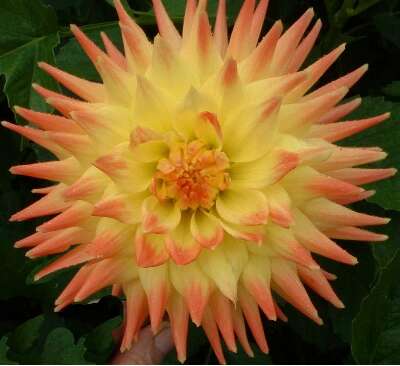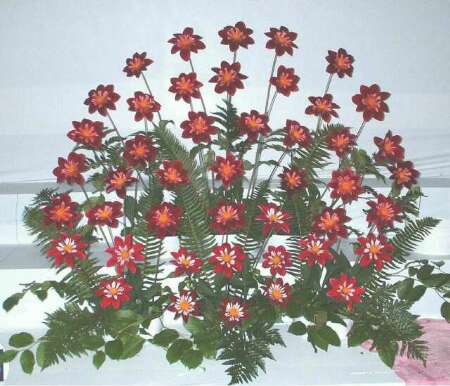 THE GROWING WORLD OF DAHLIAS
THE GROWING WORLD OF DAHLIAS
![]()
|
My introduction to hybridising dahlias began just one year after I started
growing them in 1969. I met George Wilson, then President of the National
Chrysanthemum Society, as a result of purchasing dahlia plants from his nursery
in Cricklewood, North London. He was a real character who set out to convert
anyone who showed any interest in dahlias into a dedicated enthusiast. At that
time George, who had a pacemaker, grew 1800 seedlings a year. Because of his
health he was handing over the running of the business to his family, but was
keen to see that his hybridisation programme was continued.
�Come into my Holy of Holies� he said to me one day and I found myself in his
very private greenhouse. I emerged with a small packet of �special� seed, which
George assured me would produce small decoratives only. Out of complete
ignorance I was completely unimpressed, having only reached the stage of knowing
about the ten classifications of the dahlia.
Throughout the dahlia flowering season George walked around his plot with a
couple of small brushes in his pocket and was prone to tell anyone who was in
earshot that he could �smell� when the pollen in a flower head was ripe! His
method was to bag the flowers he pollinated and record the parents.
I didn�t really want to get into this aspect of dahlia growing. Just a couple of
years previously I had seen some giant dahlias grown on the allotments opposite
my house and thought they were amazing, despite the lack of attention they
received. I reckoned that with some real dedication that I could produce some
spectacular results. However, I grew George�s seed (quite a few succumbed to
novice stupidities) and had seven quite good plants that indeed all conformed to
the small decorative classification. As I recall it the colours were nondescript
and I really did not have a clue as to their exhibition potential. Inexperience
resulted in their demise the following winter.
In retrospect the concept of producing specific classifications as outlined
above seems fanciful and that has been the reaction of hybridists to whom I have
told this experience. George was indeed an �over the top� character and this
anecdote demonstrates his persona.
My next foray into hybridisation was again as the result of meeting an extrovert
dahlia enthusiast � my great friend Jack Kinns. Like George, Jack also had a
nursery. His passion was producing new varieties of Waterlily Dahlias, although
he also had a good number of top winners of other classifications prefixed by
the �Abridge� cultivar-group name. Jack supplied me with his latest varieties,
but was somewhat �miffed� when I beat him at a National Dahlia Society Show with
HIS varieties!
So I decided to see if I could beat him at his own game and in 1996 planted 200
seedlings having Glorie van Heemstede as the seed parent. The row consisted of 4
plants across and 50 deep. When I stood at the end of the row when the plants
were in full production I was surprised by the limited range of colours � almost
all were a dull yellow with just the odd one which was red or white. The
experiment was repeated in 1997.
|
Only one cultivar remains � JUDY TREGIDDEN. This is an orange waterlily, which won a bronze medal at the NDS Trials at Leeds in 2001 and is available in the Halls of Heddon catalogue. It was recorded in the 15th Supplement of the RHS International Register of Dahlias. |
|
Conversations with fellow hybridists have resulted in the observation that
received wisdom suggests that one new variety of note results from between 200
to 400 seedlings � the evidence above fits in with this contention.
In 1995 I grew 12 plants of collerettes in containers in a tunnel covered in
Rokelene netting. The varieties were THAIS, CLAIR DE LUNE, LA CIERVA and
CURIOSITY. Very few insects penetrated the netting and as a result of poor
pollination very few viable seeds were obtained. However seedling 642 was a
distinctive purple colour with a white collar. This was selected for trial at
Leeds, but in common with all collerettes did not merit an award. Subsequently
it was named Laura Ann Owen after the granddaughter of the Trials Manager, Brian
Owen, but has not been registered.
|
One other variety remains from this period - seedling 79 - which is a small semi-cactus. This is very unusual being yellow with orange tips. It is due to be exhibited in 2005 having so far been grown as a garden flower by quite a few growers. |
 |
I experimented during this period with different methods of obtaining seed other
than allowing pollination to proceed naturally, in an attempt to have some
control on the process. After discussing the procedure with Dr. Gareth Rowlands
who was a friend of mine whom I met when we were members of the Executive
Council of the National Dahlia Society, I brushed pollen from a bagged known
variety onto a selected seed parent flower. Maybe because of ineptitude very few
viable seeds were produced, so trials with any statistical significance were
ruled out.
I suggest that pollination occurs over quite a few days in the natural habitat
as the stamens open in succession, so one application of pollen on a given day
is likely to be only partially effective.
I also tried separating plants by two hundred metres and growing only one
classification on one of the sites. Unfortunately it was not possible to follow
this experiment to a satisfactory conclusion as we moved to a smaller plot of
land.
I came to several conclusions about hybridising dahlias at this stage and
decided that on moving from our 3.5 acre wind blown grounds at Bickleigh to a
standard garden in Tiverton that I would put them into practice.
6 foot wide arrangement of SUE MOUNTJOY at the Harrogate National Show 2002
